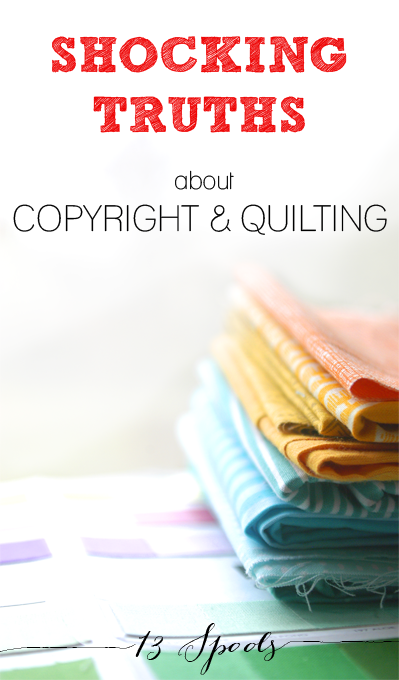Shocking Truths about Copyright: What Every Quilter Ought to Know
 Have you ever wondered about copyright in relation to your tutorials, quilts, and patterns? I'll be running a series of posts on copyright to clear up some misconceptions, talk about vague areas, and share my own opinions. I'd like to encourage you to join in the conversation in the comments at the bottom of each post - I want to hear what you think about these topics! A lot of people overestimate the reach of copyright, so we'll be starting there.
Have you ever wondered about copyright in relation to your tutorials, quilts, and patterns? I'll be running a series of posts on copyright to clear up some misconceptions, talk about vague areas, and share my own opinions. I'd like to encourage you to join in the conversation in the comments at the bottom of each post - I want to hear what you think about these topics! A lot of people overestimate the reach of copyright, so we'll be starting there.
What does copyright protect?
From the United States Copyright Office: "Copyright, a form of intellectual property law, protects original works of authorship including literary, dramatic, musical, and artistic works, such as poetry, novels, movies, songs, computer software, and architecture. Copyright does not protect facts, ideas, systems, or methods of operation, although it may protect the way these things are expressed."*
Example: Paper Piecing Instructions
Copyright does not protect the method of paper piecing I use. I can't copyright that, even if I came up with a unique method. Copyright does protect written instructions for my method.
I can write a book, a pattern, or a blog post, with specific paper piecing instructions, written in my own, original words. Any photographs, diagrams, and text in these instructions would be copyrightable, because they would be considered "the way these things [paper piecing, in this instance] are expressed."* I am expressing the method of paper piecing that I use through the instructions.
If anyone else learned my method, and wrote their own instructions in their own words, with their own photographs, and their own diagrams, they could also copyright their instructions - even if the method was, in essence, the same. That's because paper piecing would be considered a "method of operation", and not copyrightable. Again, the Copyright Office asserts: "You may express your ideas in writing or drawings and claim copyright in your description, but be aware that copyright will not protect the idea itself as revealed in your written or artistic work."* (emphasis mine)
That being said, only the owner of copyright owns the exclusive right to "prepare derivative works based upon the work". "The work" refers to the item I made, and any copyrightable aspects of the directions I wrote (and photos/diagrams), not the method, which is why it's ok for you to write your own version of directions. Extremely basic directions are not copyrightable, because they are considered "methods of operation". But you can't take my blog tutorial, photos and all, change a few words, and call it your own - that would violate copyright.
Clear as mud?
There's a lot more to this topic, and no way I can hit it all in one post. So stick around, as I'll be posting more on the topic of copyright in the next few days.
// Coming up: Can I sell Quilts Made from a Copyrighted Pattern? //
